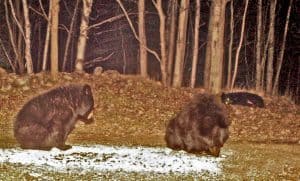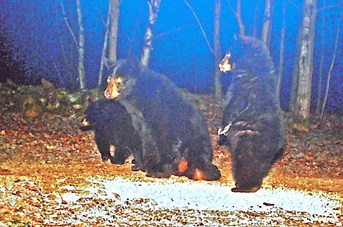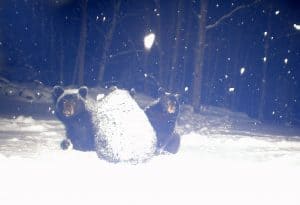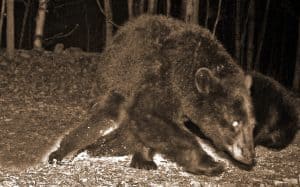“There is no fundamental difference between man and animals in their ability to feel pleasure and pain, happiness, and misery.”
Charles Darwin, The Descent of Man
A decade or so ago, I came upon a considerable mystery. It was a fall afternoon and, while walking down the road toward my home in the Haliburton wilderness, I noticed enormous undulations on the dusty road. A snake perhaps? Now I knew no part of Ontario, or indeed any place on earth, held a snake that huge, at least I hoped not. The S-shaped pattern was approximately 75 cm wide, but its length was uncertain. I thought this beast must swallow deer for breakfast and dine on moose for lunch. My imagination was racing. Adding to the mystery were the occasional patches of dark blood—the remains of prey perhaps?
I have cameras that take photographs automatically when sensing both heat and motion. While these camera traps take photos, I’m usually at home drinking Glenmorangie single-malt scotch. To photograph the extraordinary animal that made these tracks, I attached one of my special cameras to a tree overlooking its trail. And I placed a large quantity of cracked corn, on the off chance the creature was a herbivore, and four pounds of hamburger in case it was a carnivore—the more likely choice. I activated the camera and departed.
The following morning I could hardly wait to check the site. As I approached I saw that all the food was gone, every bit of it, and that there were tracks everywhere, including those of this undulating monster. More significantly, the display window on the camera revealed it had taken 186 photographs. Jackpot!
I replaced the memory chip and ran home to boot up my computer to view these pictures. And what did I see? Bears, black bears, lots of them but no undulating monster. One large mother bear (sow) came early in the evening with her two small cubs—probably females. Four hours passed before a second mother bear arrived with her two larger cubs—probably males. (Each photograph is time stamped.) But still I saw nothing to explain the strange undulations. What was I missing? I had photographs of the two different sows. Where was the monster?
Then I saw the problem. The solution to the mystery was obvious, but so incredibly improbable. The mother bear in photograph 1 had no use of her hind legs. She was a paraplegic! Note the worn-away fur and exposed flesh on her back legs plus their unnatural position. Unbelievably, she was dragging herself everywhere, and this was the source of the undulations. There was no monster, just a mother bear of inconceivable endurance determined to feed her cubs and herself. I decided to call her Mother Courage.
I contacted the Ontario Ministry of Natural Resources (MNR) about what we should do to help this injured bear. “We” quickly became “me.” But they did suggest that, if this sow made it to hibernation, about two weeks away, the cubs would have a better chance of surviving the winter—it can be 40o below zero where I live. Until then, I decided to feed Mother Courage and her cubs at my back window so that I might observe their behavior. After I began, they came every night; however, I never saw the other large sow and her two small cubs again. Two weeks passed, and then two more. Would Mother Courage ever hibernate? I telephoned the MNR to ask if my feeding was inhibiting them from going into hibernation—the officials said no! Another two weeks came and went; it was now the middle of December, and this family often arrived during a blizzard. The cubs were always first by several minutes until this heroic animal dragged her bleeding backside out of the deep forest only to collapse in exhaustion. On many occasions, she never ate—she just watched her cubs devour the cracked corn and dog food.

Note the exhausted mother at the back right and the concerned cub at the front left. Her mothering instincts could challenge those of most humans. Gord Harrison
I became curious about the location of their wintering den. I surmised finding her lair would be easy. It must be close; after all, how far can an animal drag itself? After an hour’s trek I reached an embankment sloping down to an ancient glacial lake and located her den. This daily journey—both ways—would have intimidated Marco Polo. Yet Mother Courage had done this every day for weeks, perhaps even months. I was stunned by the magnitude of her endurance and the power of her instincts. Neither torn flesh, nor exhaustion, nor death itself I thought would prevent her daily rounds. Some will say I am anthropomorphizing; I would say it is simple empathy with a fellow mammal in great anguish.
By comparing my initial photographs to the later ones, Mother Courage appeared to be losing body fat. So, on December 17, I decided not to feed her and her cubs anymore hoping to force them into hibernation, lest she die crawling. It was a melancholy evening for everyone. They came. They searched. They left. And I never saw them again.
Early in the New Year, I snowshoed to the den and was elated to find they were all safely asleep—or as asleep as hibernating bears ever truly get. The den entrance was encrusted with ice crystals caused by their emanating body heat. My flashlight revealed the back of a bear almost completely blocking the entrance in an effort to retain this heat. I took this to be Mother Courage in her ultimate act of protection for her cubs. She was following those deep instincts that had preserved her genes through a million years of evolution.
Clearly, this mother bear was exhibiting behavior that can only be described as moral. And just as clearly, this behavior was preserving her genes by enhancing the chance that her two male cubs would survive and reproduce. There was pressure for moral behavior, stemming from natural selection, because this behavior is adaptive for the preservation of genes, which are life itself. In his book Darwin’s Dangerous Idea, Daniel Dennett calls evolution by natural selection “the best idea anyone has ever had.”
Photograph 3: Mother Courage and Her Children
At my latitude, the average date for bears to come out of hibernation is April 10, so, about two weeks after this date, I revisited the den site. The MNR had assured me that this sow (Mother Courage) would not exit the den alive—I had to see for myself. I found the den again. It was empty, the entire family had left. In the distance was a kettle of turkey vultures, and I wondered if they were recycling Mother Courage. I suspected as much, but I declined to investigate.
Male bear cubs will depart from their natal territory—following the instinctive taboo against incest by Ursus americanus. Genetics tells us that inbreeding is generally detrimental to the gene pool. And, again, natural selection is the source of our discomfort and bears’ avoidance of this practice. It’s significant that sows will share territory with their female cubs since this sharing presents no danger of incest.
Many readers may have wondered how Mother Courage came to be a paraplegic. Only two reasonable speculations are possible: she was either hit by a car or shot by a hunter. It was bear hunting season when I first noticed the undulations on my dusty road.
Some moral behaviors exist outside of, and independent of, humans. If as a species, we had never existed or had gone extinct—and 99 percent of all species have—morality in terms we could recognize would still be flourishing on this planet.
Humans have driven thousands of species to extinction, and another universe must pass away before such creatures will ever come again. I am not a vegetarian, but I would speak for all those who cannot speak for themselves.
All herd or pack animals have a large moral repertoire: whales, elephants, and wolves. Naturally, moral differences exist between humans and other animals just as they do among all individuals of the same species including Homo sapiens. It’s a matter of degree not of kind.
To the shock of those who are stony faced and stony minded, the evidence that humans, apes and monkeys, whales, elephants, wolves, and even rats and mice inherit ethical behaviors honed by natural selection is profoundly disturbing. But should it be? We are a part of, not apart from, all life on earth. We are not descended from angels or demigods but ascended from ape-like creatures. Ours is a heroic past, at times so close to extinction that a wink might have made it so. Darwin would be delighted to witness this expansion of morality to non-human animals by natural selection.
In the last photo, taken on a bleak November night, Mother Courage is just hanging on to life. But, in my mind’s eye, she will always be one of the bravest and most caring creatures I have ever known.
Do not go gentle into that good night.
Rage, rage against the dying of the light.
Dylan Thomas
This article comes from my book My Cousin & Me: And Other Animals available at Amazon and Avant-Garden Shop in Peterborough. Gordon Harrison is a writer and wildlife photographer can be reached at harrison153@gmail.com


